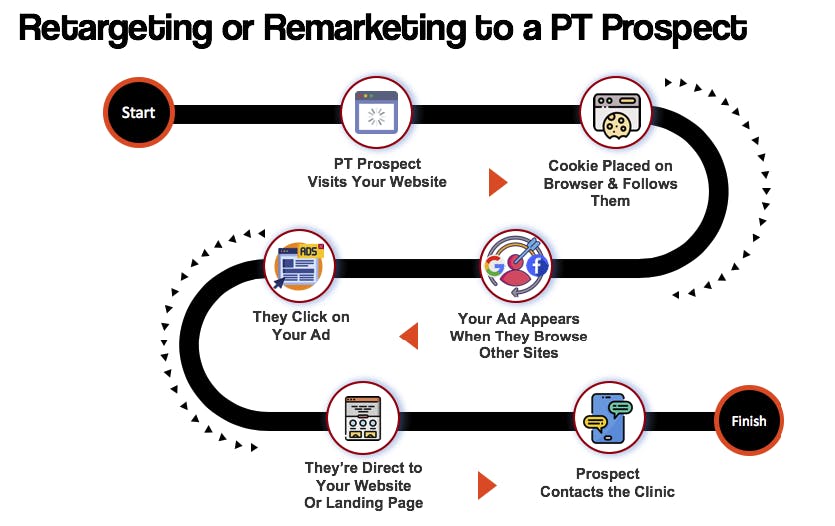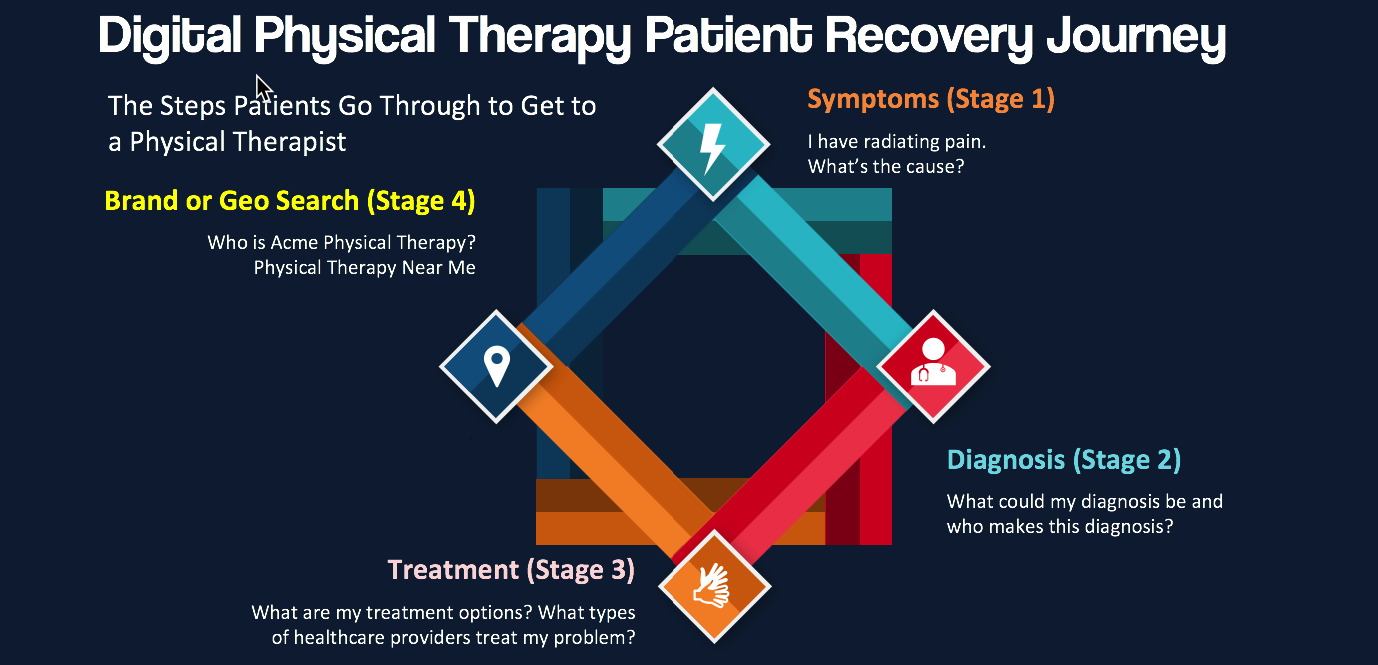Patients are at Different Stages of the Recovery Journey
Stage 1 – This is the group of people that are earlier on in the quest for recovery. Looking at our diagram at the top of the page here, these patients are suffering with symptoms. Another way to put is is these patient are higher up in the funnel, have a pain or problem and are looking for a solution. For example, they have radiating pain in their arm or leg. They don’t know what their diagnosis is, what their treatment options are, or who they should see for treatment. They are searching Google or Bing for a solution.
Stage 2 – This group of people thinks they know what their problem is, they received a diagnosis from Doctor Google or Doctor Bing. Now they need to confirm it and seek out treatment options.
Stage 3 – This group has a diagnosis and it often comes from a healthcare provider, e.g. a medical doctor. The medical doctor may recommend pills, diagnostic tests, injections, or surgery. Often dissatisfied or seeking alternative treatments, patients at this stage will search Google or Bing for treatment options for their diagnosis.
Stage 4 – This group understands their condition, diagnosis, treatment options, and is now seeking out a particular provider in a given business category…i.e. a physical therapist or as it’s known in Google search results, a physical therapy clinic.
So, the fundamental question is: how does a PT practice owner get their name in front of patients that are in different stages of their journey?
Option 1: Inbound Marketing
Inbound marketing (check out the definition on Google/Hubspot) https://www.hubspot.com/inbound-marketing . The way I like to describe this is having valuable content that ranks on the search engines with a link to your website, when someone is searching on Google or Bing.
An example of this can be seen when you search for “lower back pain treatment in Visalia” . Having a link to your website when that search is done brings “inbound” traffic to your website. Pay Per Click Ads (PPC Ads or Google Ads formerly Google AdWords) is also a form of inbound marketing https://blog.nextinymarketing.com/inbound-marketing-vs.-pay-per-click (note that PPC ads for conditions are expensive, competitive, and often hard to track).
Creating Content for Leads that Don’t Know PT is an Option Yet
A content marketing strategy is used to define the types of content your patient prospects may one to consume. Depending on the the buying process stage the consumer is in, dictates the type of content that is created.
Let’s say a potential lower back pain patient is in Stage 2, as defined above. They have a diagnosis they derived from Dr. Google or even a diagnosis from a physician…but they aren’t sure what type of treatment to pursue. You might want to create a blog post about 5 reasons why you don’t want to have an MRI if you have lower Back Pain.
If someone does a search for why lower back pain patients don’t need MRIs, they might find your content…if it ranks on Google. This would be inbound marketing.
Option 2: Outbound marketing.
Facebook ads are an example of outbound advertising. The practice owner or marketing agency pushes a message in front of a targeted group of people in the community, hoping several of this group have pain, are looking for a solution, will click on the ad. Contrast this with Segment 1 that was actively searching for a solution on Google or Bing.
If you wanted to “push” this same message, 5 reasons why you don’t want to have an MRI if you have lower Back Pain, out to your community, then you could advertise this content on Facebook. It can be delivered on your Facebook page timeline and boosted, or advertised with the Facebook ad platform.
Similar to above, a link on a Facebook ad should go to a dedicated lead magnet landing page where the prospect is asked to make a micro commitment…in most cases entering their name and email address, to get information about how the therapist can help. A follow up sequence is implemented usually via email to nurture the prospect to the next step in the funnel which might be an invitation to a workshop, or educational session, or free assessment.
Keeping Your Business Name in Front of the Lead with Retargeting

Physical therapy retargeting is an advertising method that keeps your brand solution (e.g. PT for lower back pain) in front of your leads.
Let’s continue with the marketing example above. The prospective patient visits your website because they searched for a solution, clicked on a Google link that took them to your blog post, or you blasted a Facebook out to your community about lower back pain and why patients don’t need an MRI right away. In either case, the lead has visited your website. At this time, a cookie, or small piece of code is placed on the lead’s browser. Second, this cookie is read by Facebook and the next time the viewer visits Facebook and potential patient is presented with an ad and an offer. Here we are using inbound or outbound marketing in combination with retargeting or remarketing.
Note: as of the writing of this blog post, Google doesn’t allow PT practices to retarget their users…they consider this a violation of the Google users’ privacy.
Retargeting Visitors by First Driving Them to Your Website with Offline Ads
Another form of retargeting can occur when patient prospects visit your website directly from an offline ad, a person or doctor who referred them to your website, or when the prospect clicks on a link somewhere else on the web or from a link on a search engine and visits your website. Again a cookie, a small code file is placed on the prospect’s browser, indicates that the prospect visited your website and should be presented with an ad or offer on Google, Facebook, or both.
Depending on the lead’s stage in the buying process would dictate the types of Facebook retargeting ads that you might try. See below for more about this.
Vary Your Retargeting Ads to Match Your Lead’s Buying Stage
If someone visits your website, how do you know which stage of the buying process they are in? Often times you don’t. Therefore, your retargeting should account for this by presenting the lead a variety of ads over time. Since the sales cycle for physical therapy isn’t that long, maybe you run each retargeting ad to your prospect on Facebook for a few days each.
- The first of the retargeting ads might suggest physical therapy for back pain. In this case the lead isn’t sure which healthcare provider is best for their problem. Your ad addresses this.
- Another ad, one for patients that are actively seeking a physical therapist, is designed to make your practice stand out. The retargeting ad might include featuring your five-star reputation.
- Finally, for patients that are aware of you, but are sitting on the fence, yet another might be an offer for a free exam or a discount.
Is Part of Your Advertising Campaign Retargeting? Retargeting is an advanced advertising strategy that some of asked us about, so we have presented a high-level summary of what it is and it’s potential uses.
In Summary
Above, we outlined some basic concepts around the stages of the buying process of physical therapy.
Then we described two different methods that you can use to get your name in front of leads – inbound marketing (creating content that ranks on Google), and outbound marketing, which usually takes the form of an online ad (e.g. a Facebook ad) or an offline ad (an ad someone might see on a postcard, in a newspaper, or magazine).
Finally, we described how you might be able to keep your name in front of a potential patient using a marketing method called retargeting/remarketing. When you retarget, you need to try to match your ad with the stage of the buying process your potential patient is in; therefore, your retargeting ad message should vary.
Want to Know Which Marketing Method is Best?
Schedule some time with us by clicking here. We’ll discuss your objectives, current marketing strategies, and share some thoughts on how we might be able to help.

